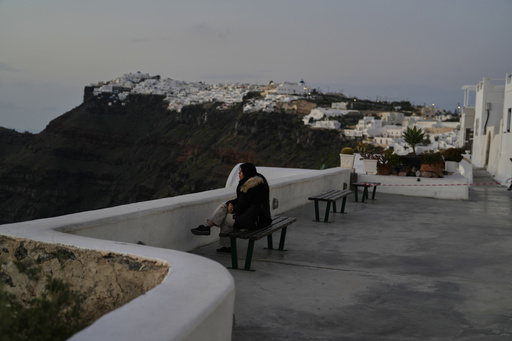In Santorini, Greece, emergency services were mobilized on Monday as a surge in seismic activities spurred hundreds of residents and tourists to evacuate the famed volcanic island. The uptick in undersea earthquakes has raised alarms about the possibility of a significant earthquake. Consequently, schools on Santorini and three other nearby islands will be closed through the end of the week.
Authorities extended safety measures to certain Aegean Sea islands popular among summer vacationers, following the detection of over 200 undersea quakes in a span of just three days. Prime Minister Kyriakos Mitsotakis communicated from Brussels, reiterating the need for calm, while residents were urged to heed the instructions issued by the Civil Protection authority amidst the geological upheaval.
Residents received alerts via their mobile devices regarding potential rockslides, as numerous quakes sent echoes through the island. Some coastal areas, particularly near cliffs, were off-limits; this included the historical old port of Santorini. Civil Protection Minister Vasilis Kikilias emphasized that the protective measures were taken as a precaution and advised citizens to follow the safety recommendations closely to reduce any risk.
Experts have confirmed that the recent quakes, peaking at a magnitude of 4.9, are not directly associated with Santorini’s volcano. However, they recognize that the recent seismic patterns are alarming. Officials held discussions with scientists throughout the weekend and into Monday, leading to the decision to close schools on Amorgos, Anafi, and Ios for a full week.
The ongoing earthquakes, which persisted through Sunday night and into Monday, have left residents and tourists on edge. Michalis Gerontakis, director of the Santorini Philharmonic Orchestra, shared his concerns, stating the frequency of tremors—every 10 to 20 minutes—has heightened anxiety among the island’s inhabitants. Despite this, the philharmonic proceeded with a performance at a local church, where the tremors were felt but didn’t hinder the event.
Authorities urged individuals to minimize their time in large indoor settings and avoid areas prone to rockslides, while hotels were directed to empty their swimming pools to lessen potential damage in case of an earthquake. Emergency responders set up a temporary staging area with tents near the main hospital, equipped to deal with any emergencies. Fire brigadier Ioannis Billias reported that many locals opted to sleep in their cars out of fear.
Some residents flocked to local travel agencies to secure tickets for plane or ferry services to leave the island. Nadia Benomar, a tour guide originally from Morocco, expressed her apprehension, stating that the current situation felt different from previous earthquakes, prompting her to purchase a ferry ticket to the nearby island of Naxos for a few days of respite.
At the island’s main port, a long line of cars and people hoping to board ferries to leave Santorini steadily grew. Contrastingly, some individuals, like restaurant employee Yiannis Fragiadakis, opted to remain on the island despite the seismic activity, feeling confident in their decision as they anticipated the bustling holiday season ahead.
South Korean tourist Soo Jin Kim, visiting with family, noted that while they experienced mild tremors during their dinner, a more substantial quake at midnight left them half-worried yet still willing to continue their vacation as planned. Santorini, with its stunning crescent shape, is a favored tourist spot, boasting daily arrivals via flights, ferries, and cruises, attracting over three million visitors each year. The island is renowned for its picturesque whitewashed buildings atop dramatic cliffs formed by a volcanic eruption about 3,500 years ago.
The catastrophic eruption, estimated to have occurred circa 1620 B.C., reshaped the island and its surroundings, laying down thick layers of volcanic ash and purportedly contributing to the decline of the ancient Minoan civilization. While the volcano remains categorized as active, its last significant eruption took place in 1950.
Distinguished Greek seismologist Gerasimos Papadopoulos warned that the ongoing series of earthquakes—illustrated on live seismic charts by a concentration of activity among the island group—might indicate the potential for a larger, more severe event. He noted that while these quakes are tectonic and not volcanic in nature, the situation is evolving with increasing tremor magnitudes and shifting epicenters.
In Santorini’s main town of Fira, local authorities are designating gathering points for residents, anticipating the need for a possible evacuation. However, Mayor Nikos Zorzos underscored that the preparations are purely precautionary. He remarked on the importance of maintaining calm and managing perceptions concerning the reported seismic activity.



